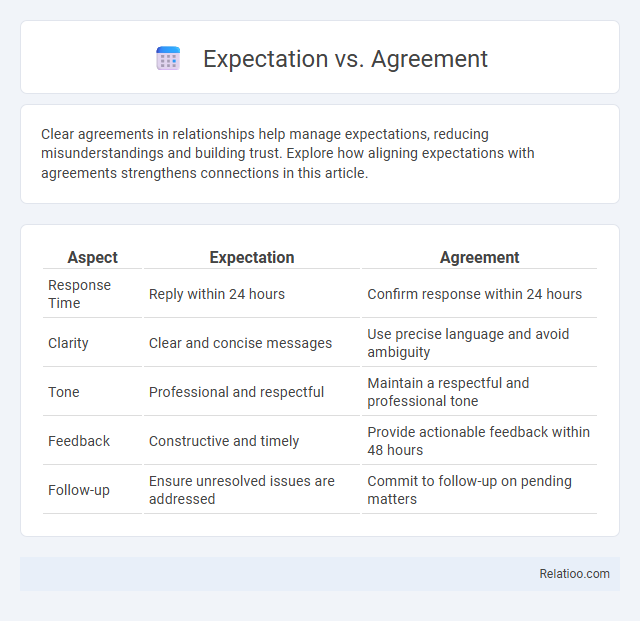Clear agreements in relationships help manage expectations, reducing misunderstandings and building trust. Explore how aligning expectations with agreements strengthens connections in this article.
Table of Comparison
| Aspect | Expectation | Agreement |
|---|---|---|
| Response Time | Reply within 24 hours | Confirm response within 24 hours |
| Clarity | Clear and concise messages | Use precise language and avoid ambiguity |
| Tone | Professional and respectful | Maintain a respectful and professional tone |
| Feedback | Constructive and timely | Provide actionable feedback within 48 hours |
| Follow-up | Ensure unresolved issues are addressed | Commit to follow-up on pending matters |
Understanding Expectation vs Agreement
Expectation represents an anticipated outcome based on personal beliefs or assumptions, while an agreement is a mutual, explicit commitment between parties outlining specific terms and conditions. Understanding the difference between expectation and agreement is crucial for effective communication and conflict resolution, as expectations are often unspoken and subjective, whereas agreements are documented and enforceable. Clarifying agreements helps manage and align expectations, reducing misunderstandings and fostering trust in relationships or business dealings.
Defining Expectations in Relationships
Defining expectations in relationships involves clearly communicating individual needs, boundaries, and goals to establish mutual understanding and prevent misunderstandings. Agreements are explicit commitments formed when both partners consent to specific behaviors or decisions, differing from expectations that may be assumed or implicit. Managing expectations through open dialogue ensures alignment and strengthens trust, reducing conflicts arising from unmet or unclear assumptions.
The Role of Agreements in Communication
Agreements serve as foundational elements in communication by establishing clear, shared expectations between parties, enhancing mutual understanding and reducing misunderstandings. Unlike vague expectations, formal agreements explicitly outline responsibilities, commitments, and outcomes, ensuring accountability and alignment. Effective communication relies on these agreements to bridge gaps between subjective expectations and objective deliverables, fostering trust and collaboration in both personal and professional contexts.
Common Sources of Expectation Gaps
Expectation gaps often arise from unclear communication, differing assumptions, and misaligned goals between parties involved in an agreement. Common sources include vague contract terms, unexpressed personal expectations, and discrepancies between verbal promises and written agreements. Identifying these gaps early can help you manage expectations and ensure mutual understanding.
How Agreements Prevent Misunderstandings
Clear agreements explicitly outline responsibilities, deliverables, and timelines, reducing ambiguity that often leads to misunderstandings. Expectations alone can be subjective and vary between parties, whereas agreements formalize these expectations into mutually acknowledged terms. This formalization fosters accountability and precise communication, preventing conflicts and ensuring alignment throughout a project or relationship.
The Psychological Impact of Unmet Expectations
Unmet expectations often lead to psychological distress, including frustration, disappointment, and decreased motivation, highlighting the critical difference between personal expectations and formal agreements. Agreements establish clear, mutual commitments that help minimize misunderstandings, whereas expectations are internal anticipations that may not align with reality or contractual terms. Managing expectations through transparent communication and realistic goal-setting is essential to reduce emotional strain and enhance satisfaction in personal and professional relationships.
Strategies for Aligning Expectations and Agreements
Effective strategies for aligning expectations and agreements involve clear communication and documented commitments. You can enhance collaboration by defining measurable goals, setting realistic timelines, and regularly reviewing progress to ensure both parties remain aligned. Utilizing transparent negotiation techniques and feedback loops helps prevent misunderstandings and strengthens trust in professional relationships.
Real-Life Scenarios: Expectation vs Agreement
In real-life scenarios, expectations refer to personal beliefs about outcomes, while agreements are formal or informal commitments that clearly define roles and responsibilities. Misunderstandings often arise when individuals act on unspoken expectations rather than explicit agreements, leading to conflicts or dissatisfaction. Clear communication and documented agreements help align expectations with actual responsibilities, reducing potential friction in personal and professional relationships.
Building Stronger Relationships Through Clear Agreements
Clear agreements establish mutual understanding and set realistic expectations, reducing the risk of misunderstandings in your relationships. Defining responsibilities and outcomes ensures all parties are aligned, fostering trust and reliability. Emphasizing transparent communication about expectations strengthens connections and promotes long-term collaboration.
Tips for Managing Expectations Effectively
Managing expectations effectively requires clear communication and setting realistic goals from the outset. Your agreement should explicitly outline deliverables, deadlines, and responsibilities to avoid misunderstandings. Regularly reviewing progress and providing transparent updates helps align expectations with the actual outcomes.

Infographic: Expectation vs Agreement
 relatioo.com
relatioo.com